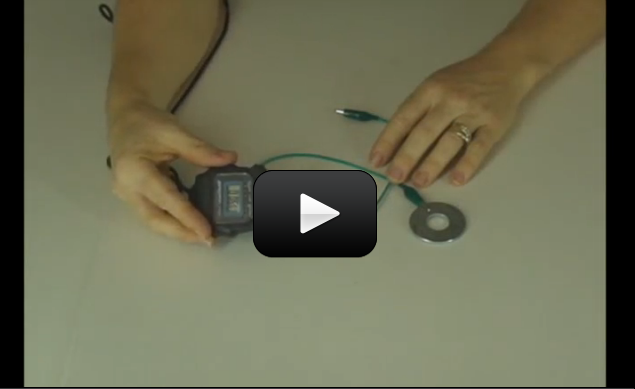In this experiment you will be adjusting the length of string of a pendulum until you get a pendulum that has a frequency of .5 Hz, 1 Hz and 2 Hz. Remember, a Hz is one vibration (or in this case swing) per second. So .5 Hz would be half a swing per second (swing one way but not back to the start). 1 Hz would be one full swing per second. Lastly, 2 Hz would be two swings per second. A swing is the same as a vibration so the pendulum must move away from where you dropped it and then swing back to where it began for it to be one full swing/vibration.
[am4show have=’p8;p9;p11;p38;p92;p16;p43;p64;p75;’ guest_error=’Guest error message’ user_error=’User error message’ ]
You’ll need:
- 3 Foot Long String
- A Weight that can be tied to the end of the string
- A Timer or Stopwatch
- Masking Tape
- A Table or Chair
- A Partner is helpful
“Advanced students: Download your What is Frequency?”
1. Tie your weight (the official name of the weight on the end is bob. Personally I’ve always preferred the name Shirley, but Bob it is.) to the end of the 3 foot string. If you’ve done the gravity lesson in the Mechanics set of lessons you’ll remember that the weight of the bob doesn’t matter. Gravity accelerates all things equally, so your pendulum will swing at the same speed no matter what the weight of the bob.
2. Tape the string to a table or chair or door jam. Make sure it can swing freely at about 3 feet of length.
3. I would recommend starting with 1 Hz. It tends to be the easiest to find. Then try .5 Hz and then 2 Hz.
4. The easiest way I’ve found to do this is to start the pendulum swinging and at the same time start the timer. Count how many swings you get in ten seconds.
5. Now, adjust the string. Make it longer or shorter and try again. When you get 10 swings in 10 seconds you got it! That’s one swing per second. You should be able to get quite close to one swing per second which is 1 Hz.
6. Now try to get .5 Hz. In this case you will get 5 swings in ten seconds when you find it. (A little hint, the string is pretty long here.)
7. Now speed things up a bit and see if you can get 2 Hz. Be prepared to count quick. That’s 2 swings a second or 20 swings in 10 seconds! (Another little hint, the string is quite short for this one.)
Did you get all three different frequency pendulums? It takes a while but my classes found it rather fun. You’ve created three different frequencies. 2 Hz being the fastest frequency. That was pretty fast right? Can you imagine something going at 10 Hz? 100 Hz? 1,000,000 Hz? I told you things were moving at outrageous speeds!
[/am4show]


I’m not getting 31.5m either.
Wavelength would be speed divided by frequency. The speed is 5 m/s and the frequency is .158 Hz.
So that would formula would be 5 ÷ 0.158 That comes out to 31.65. I think we have a typo in there, so sorry about that! I’ll get it fixed.
Hi, I have a question about answer for Frequency. Answer given on # 3 lesson 6 .( 31.5m ) I am not able to come up with this answer. Please show me how this is done.
Thank you.